
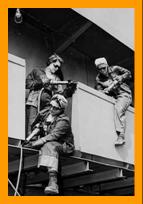
|
NON MINIATURE BINOCULARS AND OPTICS: MOSTLY MILITARY |

|
Japanese External Reverse Porro Prism Binoculars. WEBSITE MUSEUM |
|
OTHER BINOCULARS #20 & OPTICAL SIGHTS/ MOSTLY MILITARY |

|
MONTHLY NEWLY ADDED ITEMS ARE INSERTED THROUGHOUT THE SECTION AND NOT NECESSARILY ON THE LAST PAGE. Redirected search such as google image may display old content or distortion: try a refresh and or go directly to the site : http//www.miniaturebinoculars.com |



![Text Box: CLICK ON PAGE LINE. CLIQUEZ SUR LA LIGNE DE PAGE. KLICKEN SIE AUF SEITENZEILE. HAGA CLIC EN LÍNEA DE PÁGINA..[ページ行]をクリックします。НАЖМИТЕ НА СТРОКУ СТРАНИЦЫ. ALSO SEE INDEX.](image2302.gif)
|
Evolution of Nikko brand of Nippon Kōgaku Kōgyō Kabushikigaisha ( 日本光学工業株式会社 " Japan Optical Industries Co., Ltd.") Novar 7x49 and 7x50 binoculars |
|
Nikko was a brand used by Nippon Kogaku Kogyo Kabushikigaisha from 1922-1949 (per Hans Braakhuis in “Nikon Catalogus”). When used, it was usually part of a logotype of Nippon Kogaku in Japanese above NIKKO. Nippon Kogaku introduced the Nikko Novar model of 7x50 binoculars in 1923 and produced them for the civilian market until WWII, and for the Japanese army during WWII, and then again for the civilian/ occupation troops/ export market from Dec.1945. MARKINGS and DATES : per SCAPIN 1535 “Occupied Japan” markings were mandated from Feb 20 1947 to Dec 5 1949 on exported goods, optional until the occupation ended in 1952. US Army post exchange stores were established Nov 1945 in Japan and sold Japanese binoculars/ cameras to troops. I believe that Nippon Kogako serial numbers are probably specific to each model binocular. |
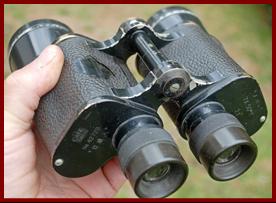
|
WWII era JAPANESE NAVY NIKKO NOVAR 7X50 BINOCULARS |


|
My Japanese Navy military Nikko Novar 7x50 binoculars #42729 have a reticule/ranging grid. They may be pre WWII or WWII and are military issued. Novar is in Japanese characters. |
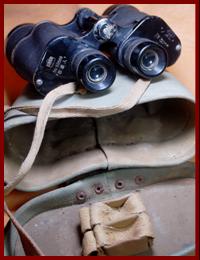
|
WWII era JAPANESE NAVY NIKKO NOVAR BINOCULARS |
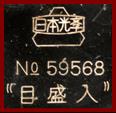
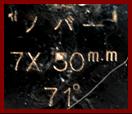


|
My Japanese Navy military Nikko Novar 7x50 binoculars #59568 have a reticule/ranging grid. They may be pre WWII or WWII. Novar is in Japanese characters. For more details see the section Other Binoculars #12 |
|
For more details see the section Other Binoculars #12 |
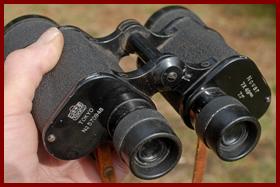
|
EARLY POST WWII JAPANESE NIKKO NOVAR BINOCULARS |

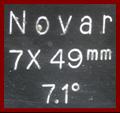
|
My early post war Nikko Tokyo Novar 7x49 binoculars #570948 have a canvas case similar to military cases ARE NOT marked MADE IN OCCUPIED JAPAN , and probably date 1945-1946 |
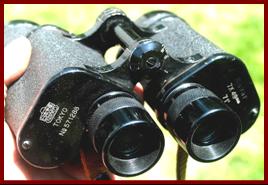
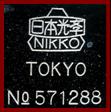

|
My early post war Nikko Tokyo Novar 7x49 binoculars #571288 ARE NOT marked MADE IN OCCUPIED JAPAN and date 1945-1946 |



|
Unknown marking |
|
My early post war Nikko Tokyo Orion 6x24 binoculars #571806 ARE NOT marked MADE IN OCCUPIED JAPAN and probably date to 1946. They are shown because of seeming to be in the serial number stream as the Nikko Novars, and and because like the early post war Nikko Novars they are a model often wrongfully listed and sold as being WWII Japanese military binoculars. |
|
Pending more acquisitions or observations, I believe I can postulate that the “made in occupied Japan“ marking of Nikko Novar 7x49 binoculars mandated in Feb.1947 probably occurred in the 119 binoculars between serial number 572893 and serial number 573012. |
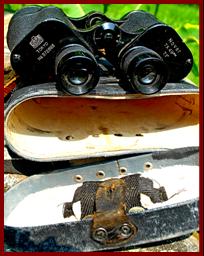

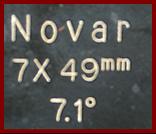
|
My early post war Nikko Tokyo Novar 7x49 binoculars #572893 ARE NOT marked MADE IN OCCUPIED JAPAN and probably date to late 1946 or January 1947 They have a canvas case similar to WWII models. |
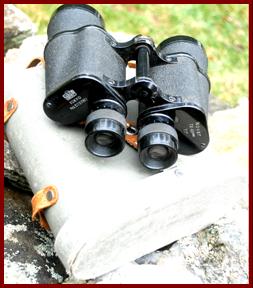
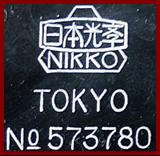
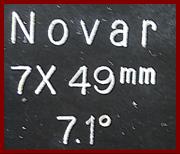
|
My Nikko Tokyo Novar 7x49 binoculars #573780 ARE marked MADE IN OCCUPIED JAPAN , and have a canvas case similar to WWII production which is also marked “ MADE IN OCCUPIED JAPAN ”. Crossing the Feb 1947 MIOJ requirement with Nikko brand data dates and closeness in serial number above these probably date to 1947. |
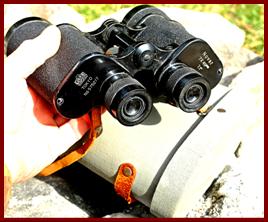
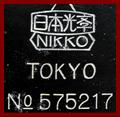
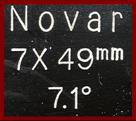
|
My Nikko Tokyo Novar 7x49 binoculars #575217 ARE marked MADE IN OCCUPIED JAPAN , and have a canvas case similar to WWII production that is also marked “MADE IN OCCUPIED JAPAN”. Crossing MIOJ & Nikko brand data dates these binoculars to Feb.1947-1949. |
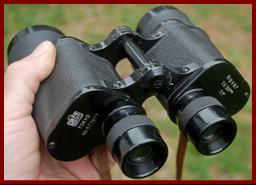
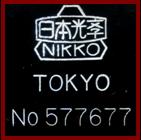
|
Pending acquisitions, observations, or info, I believe the transition of post war Nikko Novar binoculars from 7x49 to 7x50 markings occurred between binocular serial # 575428 and serial # 577087 and between 1947 and 1949. |

|
My Nikko Tokyo Novar 7x50 binoculars #577677 ARE marked MADE IN OCCUPIED JAPAN , and crossing MIOJ & Nikko brand data dates them 1947-1949. |
|
My Nikko Tokyo Novar 7x49 binoculars #575217 ARE marked MADE IN OCCUPIED JAPAN , and have a canvas case similar to WWII production that is also marked “MADE IN OCCUPIED JAPAN”. Crossing MIOJ & Nikko brand data it dates them 1947-1949. |

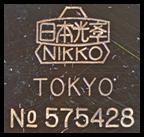

|
THANKS TO CHRISTOPHER H. FOR ASSISTANCE ACQUIRING |


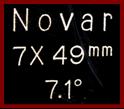
|
My early postwar Nikko Novar 7x49 binoculars #320033 ARE NOT marked MADE IN OCCUPIED JAPAN and probably date 1945-1946. |

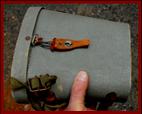
|
My Nikko Tokyo Novar 7x50 binoculars #577087 ARE marked MADE IN OCCUPIED JAPAN , and crossing MIOJ & Nikko brand data dates them 1947-1949. |
|
Ca 1917-1921 Ross 10x Stereo Prism Binoculars With an Interesting Past |

|
Inscription marked on case says: “ Leighton Hope, American Consul, Ensenada SA Mexico ” |
|
I tend to like the (many) things which I collect to include a human provenance whenever possible: a documented history beyond the bare physical object. The vast majority of objects that survive their original ownership quickly shed their human past. So for me it is a pleasure when an item defies that norm, and it is often merely because somebody wrote something on the object and the web now allows researching that significance. This is the case with these binoculars. The carry case for my Ross,London 10x binoculars is marked as having belonged to Leighton Hope, American Consul at the US Ensenada Consulate in Mexico (by records 1922-1926). The binoculars are marked as having been sold through the firm of G. Falconer & Co. Ltd. Hong Kong, which fits perfectly as Leighton Hope was U.S. Vice consul to Hong Kong in 1917, and U.S. consul to Hong Kong in 1921. He obviously purchased these British Ross binoculars in Hong Kong during his time there. As can be seen in the period (1928) G. Falconer & Co. (Hong Kong) Ltd. advertisement shown at left, Falconer were agents for and sold Ross binoculars and telescopes from their shop opposite Hong Kong’s main Post Office. |
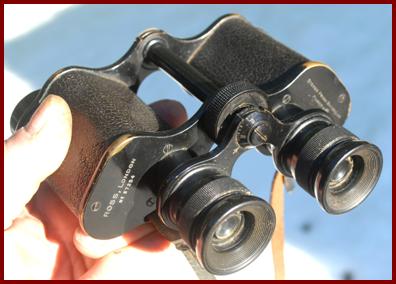



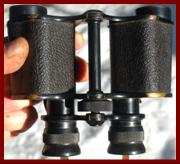


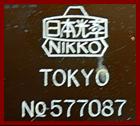
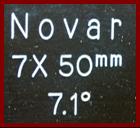
|
My Nikko Tokyo Novar 7x50 binoculars #578012 ARE marked MADE IN OCCUPIED JAPAN , and crossing MIOJ & Nikko brand data dates them 1947-1949. Note sorter eye shields. |
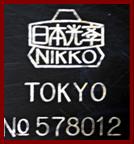
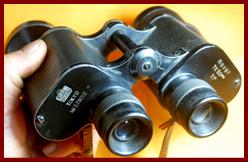
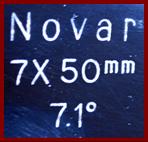
|
I believe that my Nippon Kogaki Tokyo Mikron 7x50 binoculars #677176 are the post 1949 successor in markings to the Nikko Novar 7x50 binocular products, and date around 1949-1952 (post Nikko name use, and post Made in Occupied Japan mandated markings, but prior to the end of US occupation (speculative). Eye shields have been shortened to accommodate eyeglass wearers. |
|
Since goods sold to the Japan domestic market during US occupation were substantially taxed, and all goods sold at U.S army post exchange stores to US solders at the time were not taxed, a percentage of goods sold at army post exchanges including cameras, hi fi equipment, and binoculars were marked “EP” to prevent US soldiers reselling untaxed goods back into the Japanese domestic market. No direct documentation appears to be currently known on the exact literal translation or administering authority on the EP abbreviation markings, but speculative general consensus on the “EP” markings is (tax) “Exempt Product”, or “Export Product” or (tax) “Exempt Purchase”. |
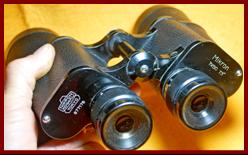


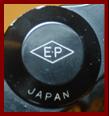
|
Ca. 1960’s British Wray Wraylite Armia Krajowa Shuzba Zwyciestwu Polski (Home Army Shuzba to the Victory of Poland) 8x30 Commemorative Presentation Binoculars |
|
Wray Optical Works Ltd. (Bromley Kent) existed 1850-1971, when it closed because the value of selling the physical assets exceeded the value of running the company. I believe this Wraylite model to be from the mid 1960’s. Armia Krajowa Tuuzba Zwyciestwu Polski (home army for the victory of the Polish) was the Polish resistance organization in German occupied Poland 1942-1945, and this seems to be a Wray Commemorative model, given as a retirement gift to an employee W.S. Sanders by Pilkington Brothers Ltd, who is a UK glass manufacturer in Lancashire. |
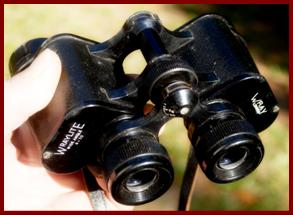



|
Military service was the major life event for many, and commemorative markings (battles, units, theaters of war etc.) are seen on many veteran items (helmets, packs, trunks, etc) and on many non military jackets, caps, license plates, mugs.... And also binoculars. |
|
Busch Marluxon 7x50 military army binoculars |
|
The German Busch Marluxon model of binoculars were introduced in 1913, and they produced until around 1939-1940. My binoculars were apparently used by a European army (based on military strap to attach to uniform and typical military pattern ocular cover. |
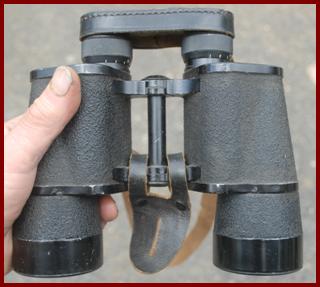
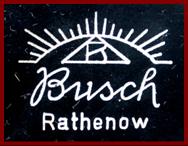
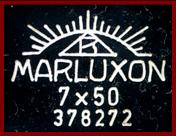
|
1942 Universal Camera Co U.S. Navy binoculars MK XXX Mod 0 marked post war to the U.S. Navy Optical School |
|
The U.S Navy established an OM / Optical Man rating in 1943 to provide Navy personnel trained to repair/ overhaul and service binoculars, telescopes, range finders, submarine and turret periscopes, navigation optics, night vision optics, fixed prism gunsight telescopes, etc. In 1945 the navy formed the US Navy Optical School at the Naval Station Yorktown for training. |

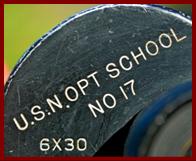
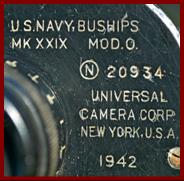
|
My 1942 Universal Camera Co U.S. Navy binoculars MK XXX Mod 0 were marked as binocular #17 property of that school. |
|
WWI British Military 6x30 Binoculars Produced Under Contract by Crown Optical Co. serial #9518 |
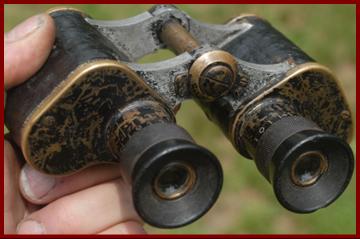

|
The Crown Optical Co. of 203 State St. in Rochester N.Y. received WWI British military contracts for binoculars in early WWI, including the British binoculars contract #B750-579W of 7/15/16 ($350,000) and the British binoculars contract #B1264-1015W of 5/14/17 ($350,000). Obtained in the UK. |

|
Broad arrow British property mark |



|
Facing Broad arrow British military disposal mark, when sold as surplus. |
|
U.S. Navy 6x30 Crown Optical Co military Binoculars with ocular filters serial no. 87711 |
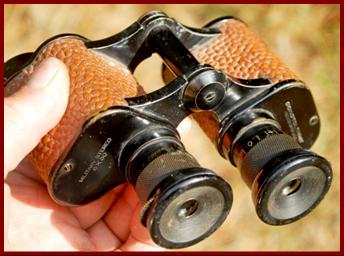
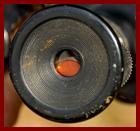



|
The Crown Optical Co. was formed in 1906 as a US lens and binoculars maker, and was located at 203 State St. in Rochester N.Y. They produced binoculars for the U.S. Navy in the mobilization prior to WWI. Crown Optical Co. existed 1906-1918, when seized by the U.S. Navy, which mean the Navy didn’t have to pay existing contracts. |


|
Second Section on transits at bottom of page. |

|
1918 Zeiss DF 6x24 Imperial Imperial German Navy Kriegsmarine marked Dienstglas marked military binoculars serial # 950091 |

|
Zeiss manufactured their DF 6x24 military binoculars from 1909 to 1931 (per Hans Seeger “Zeiss Fernglasser”), and my example was marked as to March 1918, with serial number 950091, also confirming 1918 production. My binoculars have the WWI eagle M German Navy property mark. Only some German Navy binoculars are marked Dienstglas. Along with my Australian reissued 1917 Diensglas binoculars in OTHER BINOCULARS #7 these are among the earliest “dienstglas” marked binoculars I have. |

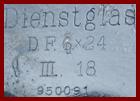

|
WWI Huet 8x French MG (Minist è re de Guerre) property marked binoculars with reticule and with a well documented and named WWI US Army history |
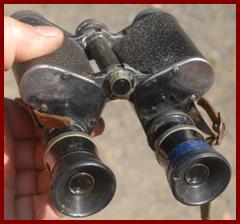
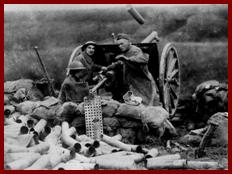
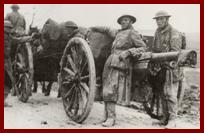
|
Batteries of the 6th Field Artillery in WWI |
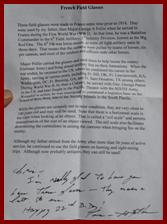




|
It is generally known that the French MG/ Ministere de Guerre (Ministry of War) provided support/ equipment during WWI when US forces mobilized and entered the war. I have found multiple indications in assembling this collection that it included supplying MG contracted binoculars. The most conclusive are these MG marked Huet binoculars which came with a letter from a father gifting them to his son, and stating that his father Major George A Pollin had been a brigade commander in the 6th (horse) Field Artillery of the 1st Infantry Div (Big Red 1) during WWI, and that he had used these throughout the war to direct artillery fire on German army positions. |

